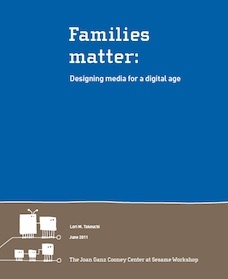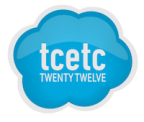 In Families Matter, the Joan Ganz Cooney Center at Sesame Workshop’s most recent research report (released May 2011), I take an ecological approach to chronicling how digital media are shaping childhood, parenting, and family life (Bronfenbrenner, 1977). I do so by sharing findings from two complementary studies: a national survey of parents of 3- through 10-year-olds, and in-depth case studies of two young Latina girls and their families. Gabriela Guzman and Sierra Ramirez’s cases provide rich examples of the potential that video games, mobile devices, and websites hold for children’s learning, as well as the threats they pose to their healthy development and family dynamics.
In Families Matter, the Joan Ganz Cooney Center at Sesame Workshop’s most recent research report (released May 2011), I take an ecological approach to chronicling how digital media are shaping childhood, parenting, and family life (Bronfenbrenner, 1977). I do so by sharing findings from two complementary studies: a national survey of parents of 3- through 10-year-olds, and in-depth case studies of two young Latina girls and their families. Gabriela Guzman and Sierra Ramirez’s cases provide rich examples of the potential that video games, mobile devices, and websites hold for children’s learning, as well as the threats they pose to their healthy development and family dynamics.
In a recent staff meeting, a colleague assigned to work on the press campaign for Families Matter confessed that it made her “cringe” to know that I observed the Guzman and Ramirez families more than two years ago. “The data is old,” she declared, quite bluntly. But in research terms, I justified quietly to myself, this is the norm: all that coding and recoding, triangulating evidence, writing, and then the drawn-out review process (not to mention conflicting work commitments we academics face) typically prevent findings from being released within a year of running a study. Still, she had a point. News agencies, after all, don’t report on events that happened in 2009. And while a 30-month delay may sit just fine with academics that read the report, I could see how it might turn off our practitioner and policymaker audiences.
My intention today is not to advocate for prolonged research cycles.[1] Rather, I’m here to defend the case study. Because they’re laced with details that date their data collection, they show their age more obviously than other forms of research. And these details, I’m afraid, are what some readers may find dated about Families Matter. I observed the two case families in late 2008 through late 2009, and since then, Wizard 101 and the Kinect have ousted Club Penguin and the Wii–two technologies featured centrally in the case studies-as the devices du jour with young kids. However, what I want to argue is that Gabriela and Sierra’s stories reveal more enduring patterns of how families adopt and adjust to new technologies. In the specific contexts of these homes, we see how new media wriggle their way into kids’ lives, challenge family values, disrupt well-worn routines, and subsequently inspire parental angst, rule setting, and eventual adjustment. New platforms will come, some will stay, and many will go, but these patterns of integration will retain their currency for quite some time.
This is not to suggest that families themselves are immutable. Family members communicate, learn, and play together differently than they did 20 years ago, and parents raise their kids differently than their parents raised them–we don’t need research to tell us this much. What’s different today than in media revolutions of past is that newer technologies (e.g., iPods, texting, YouTube, Facebook), are being widely adopted by consumers within a matter of years, if not just months, compared with the telephone, radio, and television, each of which took decades. Books took a few centuries. It’s no wonder Families Matter felt dated as soon as it went to print. But these increasing penetration rates may also explain why, according to the survey featured in the report, most parents set rules around their young children’s media use on a case-by-case basis. There’s barely time to establish expectations around any new medium before the next one comes along to throw another wrench into the works.
Gabriela’s story provides case-in-point illustrations of these parenting practices against the backdrop of a 2009-vintage Nintendo DS and Motorola RAZR feature (not smart) phone, which five years from now will seem quaint compared to the devices we can only imagine 8-year-olds will be begging their parents for. And yet, I predict that in five (maybe even 10) years, the opening vignette of Gabriela’s case–about the origins of her father’s “no more useless texting rule”–will seem oddly timeless in its portrayal of the micro-level interactions involved in rule setting around new media. In fact, as data from the 2010 parent survey—the piece that lends to the report’s timeliness today–age to the point of irrelevance, the case studies will maintain, if not increase, their value. Readers will find it easier to focus on the questions and issues at the heart of the Guzman and Ramirez cases when the technologies they feature shift from being slightly outdated and therefore very distracting, to very outdated and therefore recognized as something to be ignored.
My hope is that the report’s broad audience of media producers, educators, community leaders, and parents will find the cases useful today, as well as a decade from now. Gabriela and Sierra’s stories pose more questions than they manage to answer about technological interruptions in families with young children. As such, practitioners should find the theoretical discussions surrounding each family’s unique situation helpful for thinking about and dealing with the real-life issues they face every day. But readers will need to unfasten their gazes from the devices themselves to take in the larger ecologies in which these devices are used. If they can recognize the timelessness of Gabriela and Sierra’s cases, they will be better equipped to design and use media in ways that can help children learn, adjust, and thrive in a digital age.
[1] Researchers like Katie Davis at Harvard’s GoodPlay Project are tackling the challenges social scientists face in studying topics that are rapidly changing (like children’s media use), from formulating relevant research questions, to data collection methods, to publication (is a piece still relevant if it uses data from 2007?). I look forward to the solutions they uncover.



